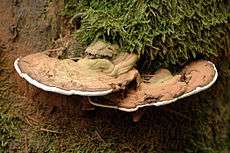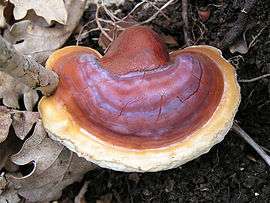Ganoderma
| Ganoderma | |
|---|---|
 | |
| Ganoderma applanatum | |
| Scientific classification | |
| Kingdom: | Fungi |
| Division: | Basidiomycota |
| Class: | Agaricomycetes |
| Order: | Polyporales |
| Family: | Ganodermataceae |
| Genus: | Ganoderma P.Karst (1881) |
| Type species | |
| Ganoderma lucidum (Curtis) P.Karst. (1881) | |
| Species | |
This list is incomplete; you can help by expanding it. | |
Ganoderma is a genus of polypore mushrooms that grow on wood, and include about 80 species, many from tropical regions.[1] Because of their extensive use in traditional Asian medicines, and their potential in bioremediation, they are a very important genus economically. Ganoderma can be differentiated from other polypores because they have a double-walled basidiospore. They are popularly referred to as shelf mushrooms or bracket fungi.
Etymology
The name Ganoderma is derived from the Greek ganos/γανος "brightness, sheen", hence "shining" and derma/δερμα "skin".[2]
Description
Ganoderma are characterized by basidiocarps that are large, perennial, woody brackets also called "conks". They are lignicolous and leathery either with or without a stem. The fruit bodies typically grow in a fan-like or hoof-like form on the trunks of living or dead trees. They have double-walled, truncate spores with yellow to brown ornamented inner layers.
Phylogeny
The genus was named by Karsten in 1881.[3] Members of the family Ganodermataceae were traditionally considered difficult to classify because of the lack of reliable morphological characteristics, the overabundance of synonyms, and the widespread misuse of names.[4][5] Until recently, the genus was divided into two sections – Section Ganoderma with a shiny cap surface (like Ganoderma lucidum) and Elfvingia, with a dull cap surface, like Ganoderma applanatum.
Phylogenetic analysis using DNA sequence information derived from mitochondrial SSU rDNA, have helped to clarify our understanding of the relationships amongst Ganoderma species.[6][7] The genus may now be divided into six monophyletic groups:[8]
- G. colossus group
- G. applanatum group
- G. tsugae group
- Asian G. lucidum group
- G. meredithiae group
- G. resinaceum group
In 1905, American mycologist William Murrill delineated the genus Tomophagus to accommodate the single species G. colossus (then known as Polyporus colossus) which had distinctive morphological features that did not fit in with the other species.[9] Historically, however, Tomophagus has generally been regarded as a synonym for Ganoderma.[10] Nearly a century later, phylogenetic analyses vindicated Murrill's original placement, as it has shown to be a taxonomically distinct appropriate genus.[8]
Significance
Industry
Ganoderma are wood-decaying fungi with a cosmopolitan distribution. They can grow on both coniferous and hardwood species. They are white-rot fungi with enzymes that allow them to break down wood components such as lignin and cellulose. There has been significant research interest in trying to harness the power of these wood-degrading enzymes for industrial applications such as biopulping[11] or bioremediation.[12][13][14]
Bioactive compounds

Several species of Ganoderma contain many bioactive compounds (~400), such as triterpenoids and polysaccharides. Collectively, the Ganoderma species are being investigated for a variety of potential therapeutic benefits:[15][16][17][18][19][20]
- anticancer effects
- immunoregulatory effects
- antioxidant activities
- liver-protecting effects
- hypoglycemic effects
- antibacterial effects
- antiviral effects
- antifungal effects
- reducing blood cholesterol
Notable species
- Ganoderma applanatum - Also known as the Artist's Conk. An infestation of this species was the main factor in the loss of the Anne Frank Tree.[21]
- Ganoderma lucidum - Also known as Reishi or Lingzhi. A very valuable medicine in Asian herbal medicine, known as the "King of Herbs".
- Ganoderma multipileum - A genomic study in 2009 discovered that populations of G. lucidum in Tropical Asia are actually a separate species.
- Ganoderma philippii - A plant pathogen.
- Ganoderma pseudoferreum - Responsible for the root rot of cacao, coffee, rubber and tea trees.
- Ganoderma tsugae - A polypore which grows on conifers, especially hemlock; thus the common name, Hemlock varnish shelf. Similar in appearance to Ganoderma lucidum, which typically grows on hardwoods.[22]
References
- ↑ Kirk PM, Cannon PF, Minter DW, Stalpers JA (2008). Dictionary of the Fungi (10th ed.). Wallingford: CABI. p. 272. ISBN 0-85199-826-7.
- ↑ Liddell, Henry George & Robert Scott (1980). A Greek-English Lexicon (Abridged Edition). United Kingdom: Oxford University Press. ISBN 0-19-910207-4.
- ↑ Karsten PA. (1881). "Enumeratio Boletinearum et Polyporearum Fennicarum, systemate novo dispositarum". Revue mycologique, Toulouse (in Latin). 3 (9): 16–19.
- ↑ Smith BJ, Sivasithamparam K (2003). "Morphological studies of Ganoderma (Ganodermataceae) from the Australasian and Pacific regions". Australian Systematic Botany. 16 (4): 487–503. doi:10.1071/SB02001.
- ↑ Ryvarden L. (1985). "Type studies in the Polyporaceae 17: species described by W. A. Murrill". Mycotaxon. 23: 169–198.
- ↑ Hibbett DS, Donoghue MJ. (1995). Progress toward a phylogenetic classification of the Polyporaceae through parsimony analysis of mitochondrial ribosomal DNA sequences. Can J Bot 73(S1):S853–S861.
- ↑ Hibbett DS, Thorn RG. (2001). Basidiomycota: Homobasidiomycetes. The Mycota VII Part B. In: McLaughlin DJ, McLaughlin EG, Lemke PA, eds. Systematics and evolution. Berlin-Heidelberg, Germany: Springer-Verlag. p 121–168.
- 1 2 Hong SG, Jung HS (2004). "Phylogenetic analysis of Ganoderma based on nearly complete mitochondrial small-subunit ribosomal DNA sequences". Mycologia. 96 (4): 742–55. doi:10.2307/3762108. JSTOR 3762108.
- ↑ Murrill WA. (1905). "Tomophagus for Dendrophagus". Torreya. 5: 197.
- ↑ Furtado JS. (1965). "Ganoderma colossum and the status of Tomophagus". Mycologia. 57 (6): 979–84. doi:10.2307/3756901. JSTOR 3756901.
- ↑ "FBRI: New Enzymes for Biopulping". Retrieved 2008-11-15.
- ↑ Matos AJ, Bezerra RM, Dias AA (September 2007). "Screening of fungal isolates and properties of Ganoderma applanatum intended for olive mill wastewater decolourization and dephenolization". Lett. Appl. Microbiol. 45 (3): 270–5. doi:10.1111/j.1472-765X.2007.02181.x. PMID 17718838.
- ↑ Rigas F, Papadopoulou K, Dritsa V, Doulia D (February 2007). "Bioremediation of a soil contaminated by lindane utilizing the fungus Ganoderma australe via response surface methodology". J. Hazard. Mater. 140 (1-2): 325–32. doi:10.1016/j.jhazmat.2006.09.035. PMID 17055642.
- ↑ Joo SS, Ryu IW, Park JK, et al. (February 2008). "Molecular cloning and expression of a laccase from Ganoderma lucidum, and its antioxidative properties". Mol. Cells. 25 (1): 112–8. PMID 18319622.
- ↑ Yuen JW, Gohel MD (2005). "Anticancer effects of Ganoderma lucidum: a review of scientific evidence". Nutr Cancer. 53 (1): 11–7. doi:10.1207/s15327914nc5301_2. PMID 16351502.
- ↑ Xu Z, Chen X, Zhong Z, Chen L, Wang Y (2011). "Ganoderma lucidum polysaccharides: immunomodulation and potential anti-tumor activities". American Journal of Chinese Medicine. 39 (1): 15–27. doi:10.1142/S0192415X11008610. PMID 21213395.
- ↑ Sliva D. (2004). "Cellular and physiological effects of Ganoderma lucidum (Reishi)". Mini Reviews in Medicinal Chemistry. 4 (8): 873–9. doi:10.2174/1389557043403323. PMID 15544548.
- ↑ Sanodiya BS, Thakur GS, Baghel RK, Prasad GB, Bisen PS (2009). "Ganoderma lucidum: a potent pharmacological macrofungus". Current Pharmaceutical Biotechnology. 10 (8): 717–42. doi:10.2174/138920109789978757. PMID 19939212.
- ↑ "Isolation and characterization of antitumor active β-d-glucans from the fruit bodies of Ganoderma applanatum". doi:10.1016/0008-6215(83)88159-2.
- ↑ "Cellular and molecular mechanisms of the Ganoderma applanatum extracts induces apoptosis on SGC-7901 gastric cancer cells". doi:10.1002/cbf.1735.
- ↑ "Horse chestnut tree diseased" (Press release). The Anne Frank House. Archived from the original on 3 October 2006. Retrieved 2006-11-17.
- ↑ Kuo M., MushroomExpert.Com, Ganoderma tsugae. (2004, February). Retrieved June 15, 2007.